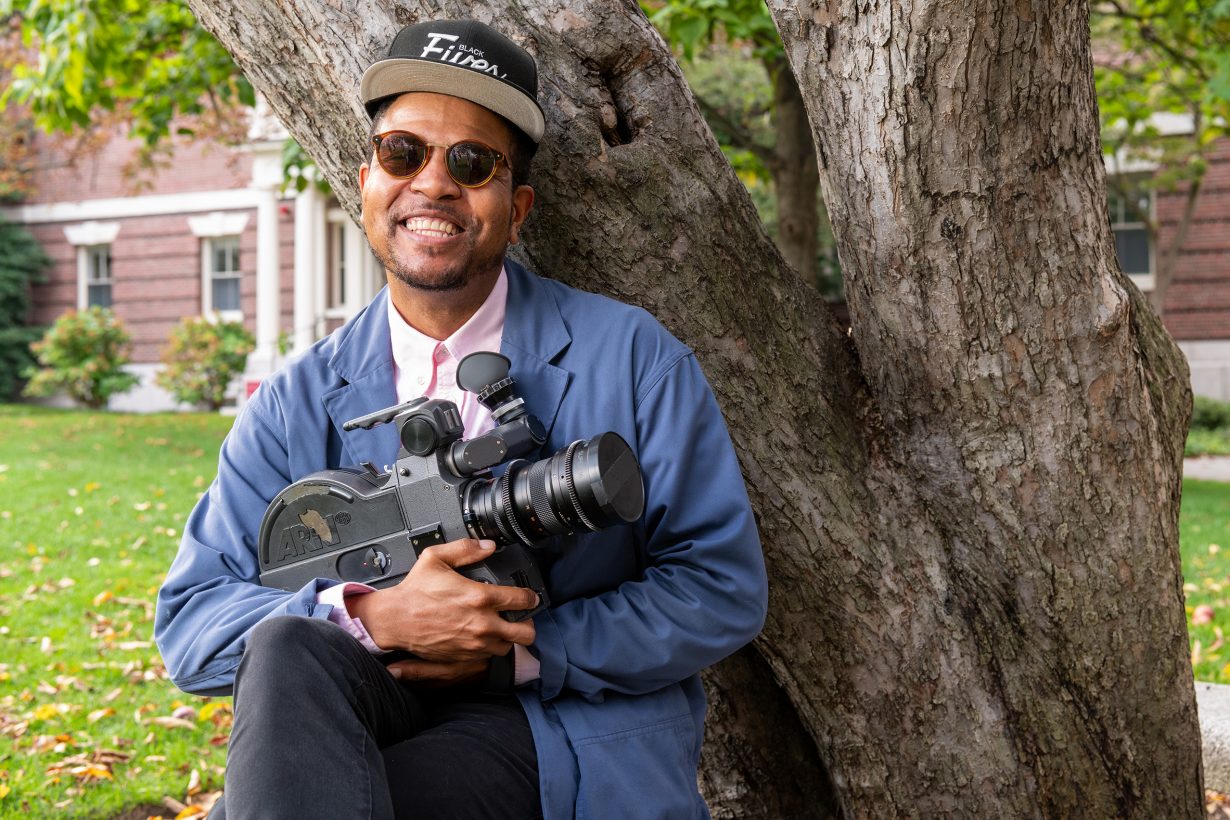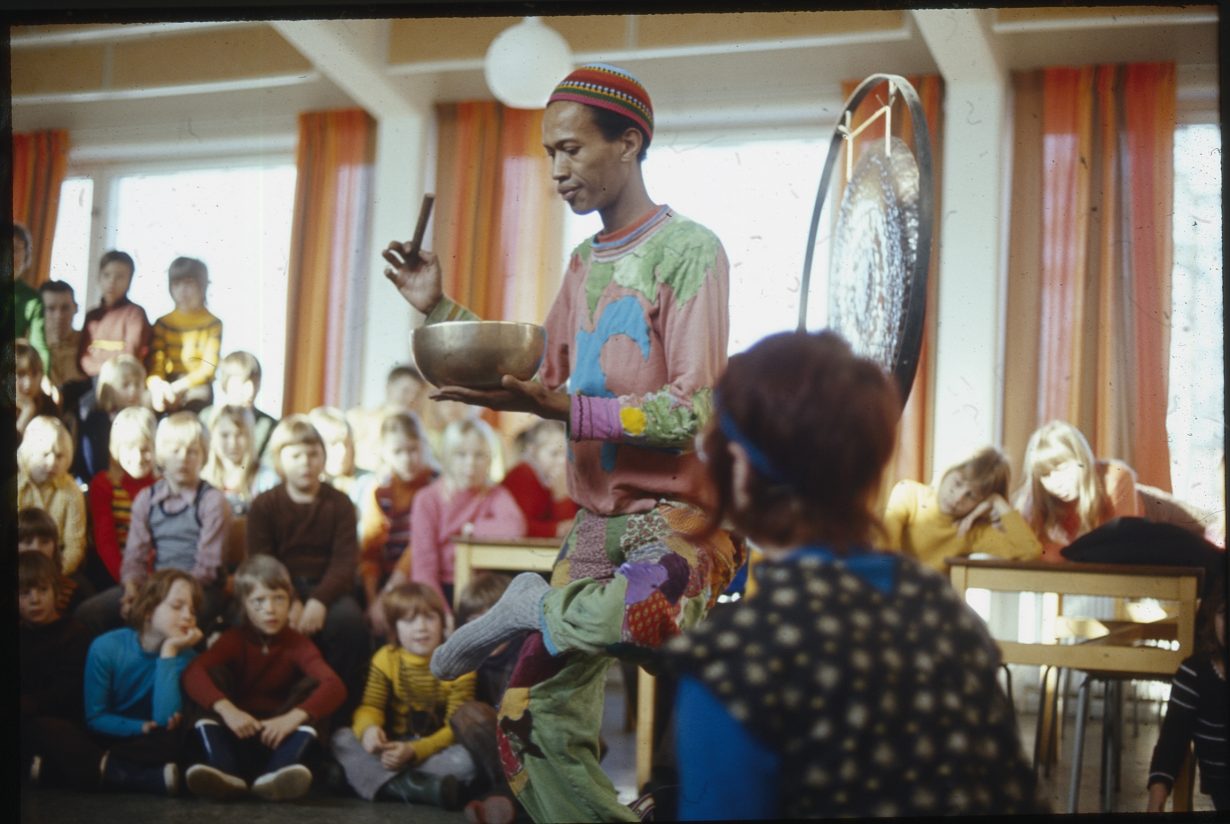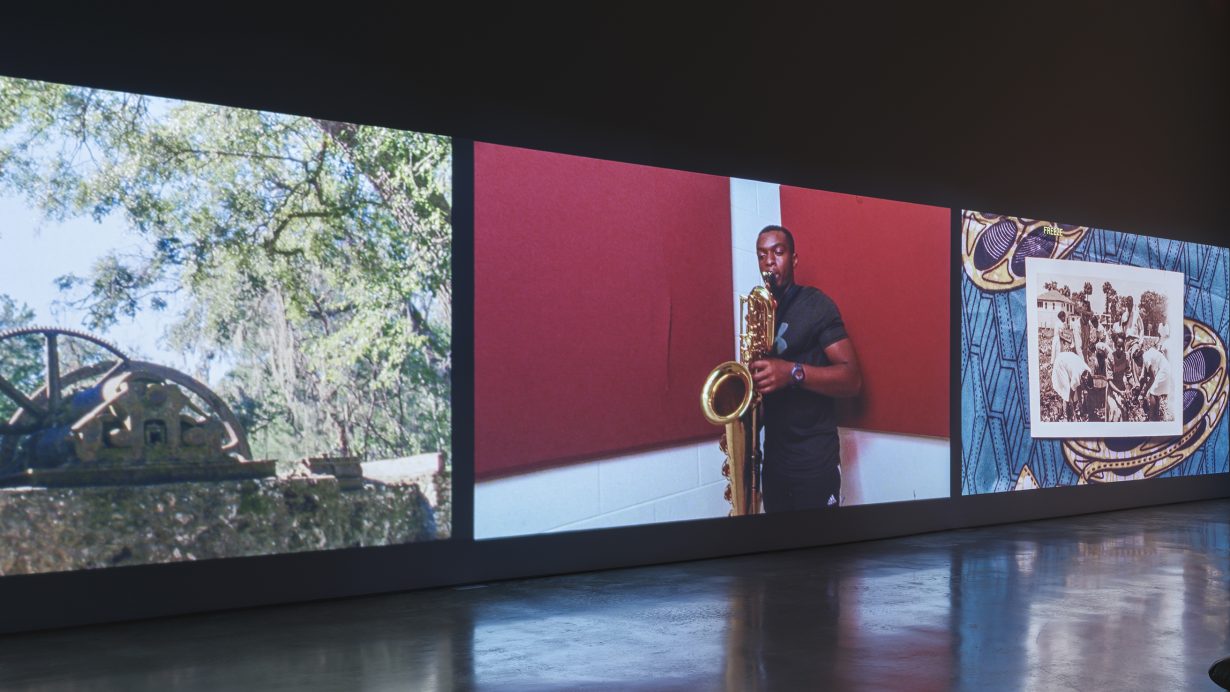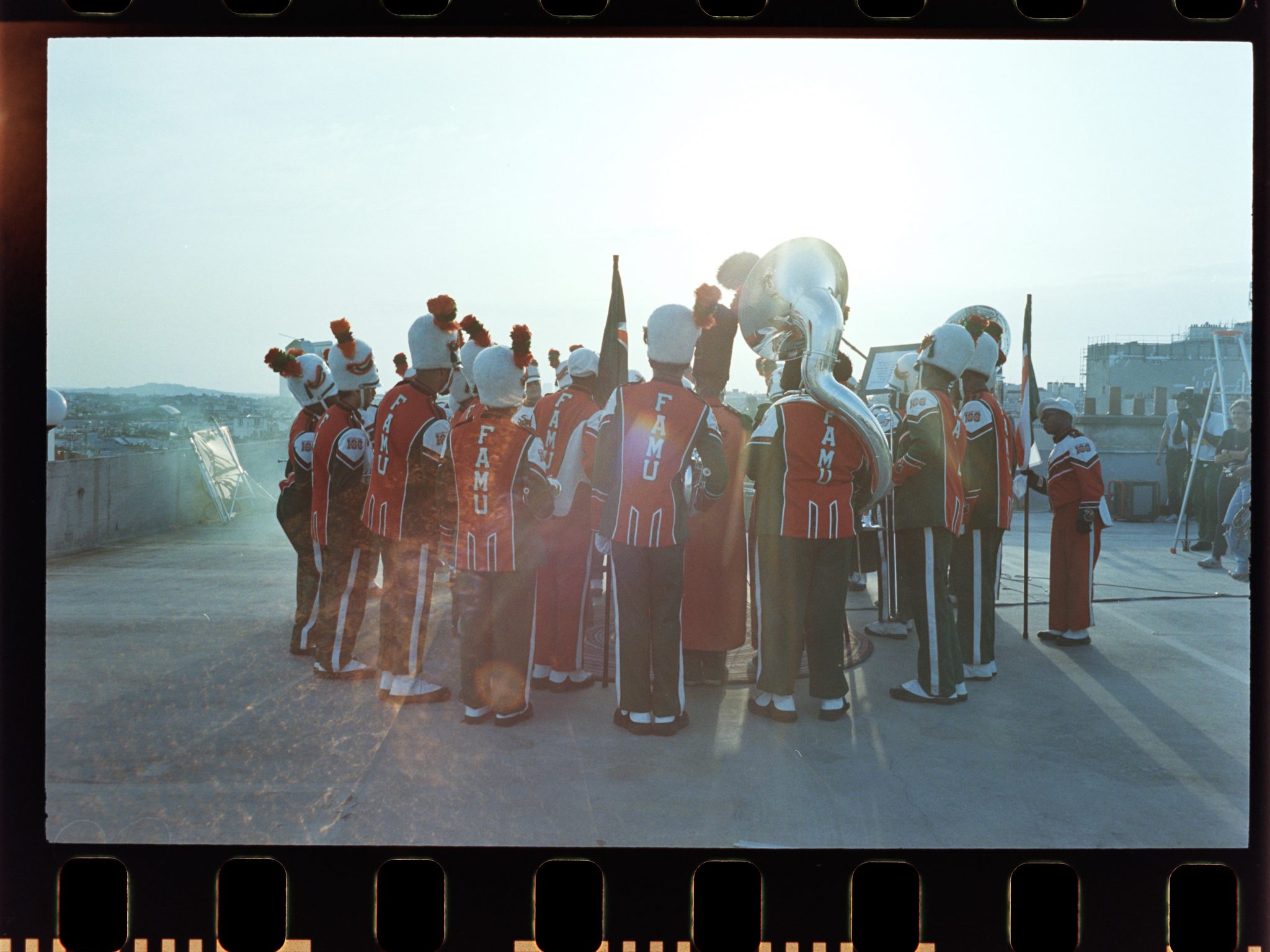“I want to make something as compelling as I can make it for myself, and then I assume that it might be interesting to other people”
Filmmaker Ephraim Asili is often the writer, producer, cinematographer and editor, as well as director, of his projects, which include works such as the five-part Diaspora Suite (2011–17) and the feature film The Inheritance (2020). The subjects in Asili’s films, which combine documentary-style extempore with critical examinations of intimacy, question how identity is affected by history, focusing on when and to whom certain histories become accessible. In a recent project titled Song for My Mother (2023), Asili traces his own family line through its contact with critical locations and events in Black history, creating a montage that demonstrates how individual narratives can hinge on popular collective narratives. Asili’s work is haptic and direct in its messaging; the message is the sonic echo that ties together the creative, the archival and the curious. His films have the effect of confetti: mirrored refractions of disjointed time showering the viewer in the moment. A 2023–24 Harvard Radcliffe Fellow, a former Guggenheim Fellow and a current Bard College associate professor, whose recent work includes directing a ‘cinematic prelude’ to Louis Vuitton’s SS23 Men’s fashion show in Paris, Asili speaks about staying grounded in the reality of what it takes to achieve a life dedicated to his artistic obsessions.

Three-Act Cage
ArtReview Your work seems like a hybrid of August Wilson’s plays, with their exegesis of Black communal thought, and John Akomfrah’s experimental films, such as The Last Angel of History [1996], which question the structure of time. In a previous interview you questioned whether the Hollywood three-act structure could lead to political freedom, and I wanted to circle back to that question now that you have worked for major corporate entities like Louis Vuitton.
Ephraim Asili Freedom is a tricky concept. Based on my experience, I don’t think there’s liberation to come from Hollywood, because the bottom line for brands and production houses is definitely money. That being said, can positive things come out of corporate entities? Absolutely, 100 percent. But overall, we’re not doing anything to make any strong changes to the status quo through these entities. I believe that I’ve been able to get a lot of positive work done. When it comes to what I think really has the opportunity to make change, to help people think through issues, maybe think differently about issues, myself included, it’s the work that I’m doing here in my studio independently. I haven’t had any situations where someone rejects my idea because it is political, but I sometimes have to tailor what I do to suit the circumstances. Years ago, primarily coming off the influence of Moonlight [2016, dir Barry Jenkins], which had a very beautiful, open structure, we were at the beginning of a really optimistic phase where new ideas around Black cinema were gaining some mainstream traction. And we thought, ok, maybe we’re headed somewhere with this Black cinema thing. When there’s money to be made from us and by us, and from radical ideas around art, then the people with the money will make money with us. But if it’s not very profitable, the gatekeepers aren’t interested.
AR Sylvia Wynter wrote about the rise of the novel during chattel slavery in the Americas, and how the three-act structure of the novel is a way to organise settler colonial space and time. Is that close to the perspective of the three-act structure you might have? That it’s like a cage?
EA Exactly. In order to have that sort of structure work, there are so many assumptions that have to be brought to the cinema, and this is why we have stereotypes and clichés. If you’re able to typecast, it sets up a parallel universe to our reality that people think they can relate to. But reality is far from that. Let’s just say we made a 90-minute movie or a two- or three-hour movie about slavery and people just washed dishes the whole time. That to me is getting closer to something interesting, getting closer to the reality of feeling trapped or enslaved. I recognise the difficulty in making a profit from a film like that, but that’s the issue. The pressure to turn a profit always takes precedence over the ideas and the form. The three-act structure is a proven moneymaker but often fails to help us think outside of the box. The bigger issue for me is how we are conditioned by cinema. We’re so deeply indoctrinated by Hollywood structure: in almost every movie somebody has a very clear problem, and then by the end they solve the problem, typically with some form of violence. Rarely do we see films go from bad to worse, but in reality that is often the case. Many times evil goes unchecked and unpunished.

AR You’re working on a documentary about experimental jazz musicians and activists Don and Moki Cherry. And you’re also working on something about Alice Coltrane. How did you choose these projects?
EA Interestingly enough, both projects chose me. I’ve been a huge fan of Don for a long time. I got into that music through Ornette Coleman when I was back in high school. Years later I went to an exhibition of Moki’s work at Blank Forms in Brooklyn, and I’m friendly with one of the people that runs the gallery, Lawrence [Kumpf ]. Lawrence actually ended up introducing me to Moki’s granddaughter, Naima Karlsson, who was interested in somebody making a film, and I was actually just consulting. After a few conversations, I realised that they wanted more of a work of art, something more in alignment with Don and Moki’s practice. Then I volunteered to make the film. She was interested in the way that I’ve been taking archival materials and activating them, and the way I play with time and linearity. For the Alice piece, Erin Christovale, a curator that I used to work with years ago, was offered the opportunity to put together a massive survey on Alice Coltrane and they asked me to put something together. And again, this is someone I had known for years that has known of my interest in Alice Coltrane’s life and music. My partner grew up in an ashram and she was kind of raised on Alice Coltrane’s devotional music, and when Alice’s ashram music started to reemerge, we were very eager to learn all that we could about that part of Alice’s life. We now have a three-year-old who’s been growing up on Alice’s music. And so, when the phone call came, it was like, wow, this is perfectly in alignment with where I’m at in life right now.

No-Style Style
AR What would be the Asili method?
EA Yeah, what is that? I hope I never truly find out because then I’ll have to retire. I think it’s really quite simple. I studied film as an undergrad. The first question they ask when you want to start making a film is: who is your target audience? I am my target audience and I want to make something to the best of my ability that is compelling to me, as compelling as I can make it for myself, and then I assume that it might be interesting to other people. There is no Asili style.
AR If we’re thinking about the history of the avant-garde, what we’re thinking about are Europeans trying to find someone new during the collapse of their society, and doing rough translations of what they consider to be primitive in Blackness, jazz and art. But when you’re Black and you’re the kind of experimental artist that you are, you get looped back into all of the inherent problems in one-sided interpretation.
EA Absolutely. I would say that was definitely the jumping-off point for the European avant-garde, but to your point, particularly for Black people in the West, our existence, our history, is avant-garde, right? It’s just a big experiment in living, and obviously all the art that comes out of that is inherently avant-garde, because it doesn’t come from a particular tradition. It’s all sort of cobbled together. And so, once you have that moment of extracting people from Africa and putting them here, you have an avant-garde culture. It’s only when Europeans find themselves dealing with the collapse of their society, where they’re forced to a certain degree to operate like the Black people that they fucked up, that they then start to develop a sort of improvised lifestyle. I embrace both avant-gardes in many ways. There is a deep relationship with Black American culture and modern avant-garde cinema, particularly between American independent cinema of the 1950s, 60s, 70s. Think of someone like Harry Smith, who was deeply influenced by people like Dizzy Gillespie. I don’t separate their art from Black art in general, because it’s influenced by Black art.

Courtesy the artist and Amant, New York
You Have to Love It
AR Before we started recording, you mentioned coming from a working-class background; you also mentioned being the producer, cinematographer, editor and director for financial reasons. What do you tell a twenty-something from the projects? They can’t afford a camera, maybe they can’t afford an iPhone, right?
EA The first thing I would ask someone in that situation is: do you genuinely totally love cinema? If the answer is anything other than yes, then I would say find any other artform to fall in love with. If you’re not in love yet, anything is better than being a filmmaker, because there are never enough resources. Whether you’re Christopher Nolan or me, there never seems to be enough money for what you want to do. You’re always under tremendous amounts of pressure, and without the resources, you can’t do the work, and that’s deeply frustrating. I think that’s the scariest thing about being a filmmaker – to feel like you have this brilliant idea, but you don’t have the means to make it.
If one is genuinely serious about filmmaking, one has to unfortunately become very serious about money at the same time, and I’m not necessarily talking about large sums of money. I didn’t care at all about money before I became interested in filmmaking. I was getting by, and I had enough to eat, my family had enough to eat, I was good. If I could buy a few records, I was good. But as I became a filmmaker, it was like, I needed money to pay for everything that I needed, and I had to find money to put aside for film production. Filmmaking is always costly, even if you’re shooting it with whatever mobile phone you have. You still need to feed people, provide transportation and ideally pay your crew, if you have one. If you can save money by taking on multiple roles, I highly suggest doing so, especially if you are just getting started.
When I was getting started as a filmmaker I worked at a grocery store, and I would just put something aside – even if it was $10 or $20 – to eventually be able to make very small short films. When people are getting started, everybody wants to make a feature film and be famous. But make a 30-second film, make a one-minute film, make five one-minute films, and that’s how you develop a voice. If you can learn how to make stuff without resources, then when they come, things will get easier. There were so many times when I’ve wanted to quit, tried to quit. I really do have this deep connection to the medium, and that love for what I do gets me through. And so, I think if people really genuinely feel that way, they’ll figure out some way to get something done, because it’s so important to see your ideas manifest that you’ll figure it out. I would say start off small, build from there.
AR What are two or three films that you saw that made you feel like you had to go create something immediately?
EA Well, the first film that did that for me, and I can remember it like it was yesterday, was Sweet Sweetback’s Baadasssss Song [1971]. When I saw that, for a variety of reasons, I was like, I gotta make a film. That was the spark for me. The second time that it happened was when I saw Chris Marker’s Sans Soleil [1983]. I just never… I was just like, whoa, what? I didn’t know a film could have that type of form. It felt so transgressive. And then the third that really did it for me was Symbiopsychotaxiplasm [1968] by Bill Greaves, which in some ways was in between the first two, but just like way further out. And with Bill’s film, it was so intellectually philosophical, in a particular type of way.
I’d never seen Black art quite like that before. I just felt completely empowered by seeing that work, which again, for me, relates to when we were talking about the avant-garde earlier. This is someone who’s totally Black but is not shying away from embracing some Western avant-garde ideas. Miles Davis did the score. After Symbio, there was no turning back from what I was doing with my life.
Jessica Lanay is a writer, poet and art journalist based in Chicago
